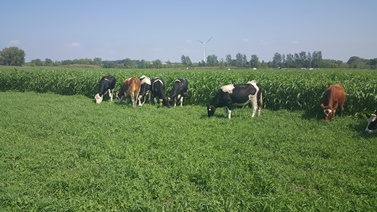By Curt Reese, Agronomy & Soil Scientist, and Esther Jordan, Communications Specialist
September 2020
Over the past few years the use of cover crops has been expanding as farmers, ranchers and land owners are finding value in the numerous benefits of planting different crops during or after traditional cash crops. A cover crop, also referred to as green manure, is a plant used in between rows, or may cover a field entirely in between crop rotations. Cover crops are planted for many reasons. Cover crops slow soil erosion, improve soil health, add organic matter, enhance water availability, reduce soil compaction, use and store nitrogen that would be lost by leaching, aid in weed control and can be used for grazing or forage. Cover crops also increase the number of plant types or crops in the rotation. With the early spring and warm weather this year, and the potential early harvest, it may be an ideal year to plant cover crops.
At the West Central Research and Outreach Center (WCROC), a portion of our crop acres are on certified organic land, largely for the purpose of supplying feedstock to our organic dairy herd. We we grow corn, wheat, oats and alfalfa, and also use cover crops in our rotation. Cover crops have multiple uses. For example, we planted sorghum and tillage radish in one field after the wheat was harvested. In early-September, we grazed our replacement heifers on the sorghum for three weeks. After the replacement heifers were moved to another pasture, tillage radish grew back which provided more plant diversity in the field. In this case, very little of the plant nutrients were removed from the field and we had three weeks of grazing. If this field had been left bare after wheat harvest, nitrogen would have leached from the soil and would not be amiable for next year's crop. Instead, most of the nitrogen is tied up in an organic form in the plant material and in the manure.
We also incorporate the use of cover crops in our manure management plan. Many farmers use custom manure haulers to spread the manure from their swine or cattle barn. There are many advantages for this. Reduced overall cost, not needing to have expensive equipment, quicker application and labor savings are a few reasons why farmers have been using custom manure haulers. However, there are some drawbacks too. Many farmers are very busy in the fall and finding time to apply can be challenging. To help mitigate this, we applied our liquid swine manure in August to an oat field. The concern when applying manure early is nitrate leaching. To get around this we planted tillage radish as a cover crop. Tillage radish has a deep tap root that can absorb and use the nitrate that would otherwise be lost.
To get the most benefit out of cover crops one must consider what you want to use the crop for. In the discussion above, we had reasons for what we planted. Other crops can be considered for different reasons.& For example, planting legumes as a cover crop such as red clover, vetch or crimson clover, can fix nitrogen (N) in the soil. This allows farmers the option to reduce nitrogen fertilizer application for subsequent cash crops.

